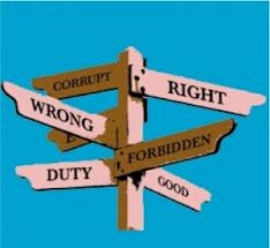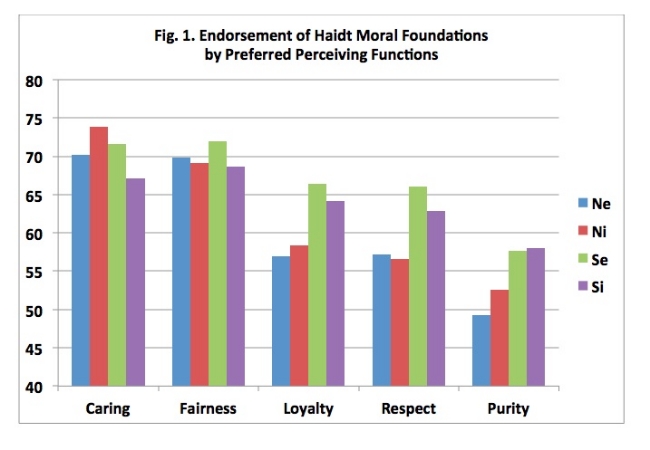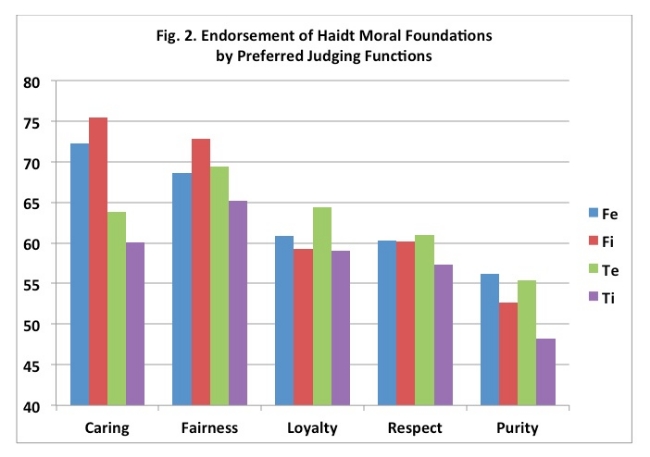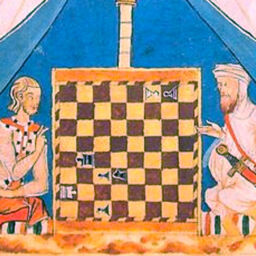
Mediating Political Differences
Liberal and Conservative Values Illuminated by the Theories of Jung and Haidt
Marlowe Embree, September 3, 2013

Liberals and conservatives often find it difficult to understand one another (Songer, 2010), presumably because they have different mental grids through which they filter their experiences and perceptions. Despite well-meaning attempts to bridge the gap, efforts at respectful dialogue often fall short. Thus, the development of a coherent theoretical understanding of the roots of ideological differences seems imperative. This paper is an attempt to forge links between Jungian type theory and an increasingly influential model of moral reasoning, Jonathan Haidt’s theory of moral foundations, in order to develop an approach to understanding and mediating ideological differences of the sort that often emerge in the political realm.
Since political terminology as utilized in the United States may not translate well into other cultural contexts, a few defining statements are in order. As used in contemporary U.S. political parlance, contemporary liberalism emphasizes a strong role for government in initiating and undergirding social reforms. The liberal perspective supports higher levels of government oversight, regulation, or intervention in free market economic activity; values civic and cultural pluralism; and takes a ‘separationist’ perspective on the relationship between church and state, seeking a more secular society. In contrast, conservativism emphasizes a smaller and less activist role for government; advocates lower levels of government intervention in the operation of the free market; affirms traditional values and morality; and adopts an ‘accommodationist’ perspective on the relationship between church and state, seeing religion as a positive good that government can benignly support (Wikipedia, 2013). Liberalism as defined above is associated with the Democratic Party, and conservativism with the Republican Party. Libertarianism, a ‘third force’ in American politics, combines a liberal stance on social issues with a conservative stance on economic issues (as the terms ‘liberal’ and ‘conservative’ are defined above). Recent opinion polling suggests that roughly 35-40% of American voters describe themselves as conservative, 30-35% as moderate, and 20-25% as liberal (Saad, 2012).
In their essays “Why I Am A Conservative” and “Why I Am A Liberal,” Cal Thomas and Bob Beckel provide an interesting contrast regarding the core elements of their respective political views as they define them. While they do not claim to speak for anyone but themselves, these two pundits do a reasonable job of summarizing what conservativism and liberalism mean in contemporary America (Thomas and Beckel, 2007). Thomas offers the following summary of conservative values (slightly edited for brevity):

Beckel offers the following reflections (again, slightly edited for brevity):
Liberals want every American to have an equal chance to achieve the American dream … To have that equal chance, every child under eighteen is entitled to decent medical care … housing, clothing, education … and to grow up … in a safe environment … Who should pay for this? You and me and every other American who was fortunate enough to have his or her basic needs met and to have succeeded financially in our country.
Note that the values articulated in these two summaries are not categorical opposites. However, the general principle holds that conservatives emphasize economic freedom and social conformity, while liberals emphasize social autonomy and economic collectivism. There are, of course, numerous variants within each position, and corresponding rifts within the two major American political parties. When the excerpts above are analyzed in terms of the five categories of Haidt’s moral foundations, they appear far less contradictory than at first reading.
Haidt’s Theory of Moral Foundations
Haidt’s (2012) model postulates the existence of a number of innate ‘moral foundations’ or ‘moral intuitions.’ While his model is fundamentally rooted in his beliefs about the nature and origin of brain architecture, rooted in notions of brain modularity that are derived from an evolutionary psychology framework, he briefly notes in his recent book that it can also be understood in terms of the concept of Jungian archetypes. Thus, it would not be surprising to find links between Haidt’s model and a Jungian framework, even though the literature to date does not appear to contain any significant indication that the two viewpoints have been explicitly linked. (It should be noted that Haidt’s use of the term ‘intuition’ does not directly parallel the technical Jungian usage. However, there are some commonalities. Moral intuitions, for Haidt, are pretheoretical and arational, not derived from conscious logical analysis. As a result, people can often articulate strongly held moral intuitions that they find difficult to justify by means of logical argument.)
In its original formulation, Haidt’s model outlined five moral foundations, which he styled caring, fairness, loyalty, respect,and purity. Each emphasizes a different aspect of moral judgment and moral evaluation, and is postulated to have distinct roots in biological and cultural evolution. If Haidt’s formulation is correct, readers should readily be able to identify which of the moral foundations most strongly govern their thinking about ethical (and, by extension, political and public policy) issues.
The caring foundation emphasizes compassion, empathy, altruism, and avoidance of actions that might produce physical or psychological harm in the lives of others. In the research questionnaire Haidt developed to measure adherence to the different moral foundations, a representative item for this category is the following statement: “One of the worst things a person could do is hurt a defenseless animal.” Another such item is: “It can never be right to kill a human being.”
The fairness foundation emphasizes equity and the avoidance of actions that lead some people to be advantaged at the expense of others, or forms of social discrimination that lack a rational basis. A representative questionnaire item for this category is: “I think it’s morally wrong that rich children inherit a lot of money while poor children inherit nothing.” Another such item is: “When the government makes laws, the number one principle should be ensuring that everyone is treated fairly.” In his recent work, Haidt has distinguished explicitly between two differing views of fairness. Liberals tend to think of fairness in terms of equality of outcomes. In contrast, conservatives tend to think of fairness in terms of proportionality of outcomes, for instance, ‘those who work harder should reap more social rewards.’ Thus, both sides can rationally claim to care about fairness even when taking opposite sides of economic policy debates.
The loyalty foundation emphasizes faithfulness to social groups (such as the family) that have a legitimate claim on an individual, and the avoidance of acts of betrayal. A representative questionnaire item for this category is: “It is more important to be a team player than to express oneself.” Another such item is: “I am proud of my country’s history.”
The respect foundation emphasizes acts that pay honor to those in positions of traditionally constituted authority, and the avoidance of social insubordination or rebellion against conventional role and status distinctives. A representative questionnaire item for this category is: “If I were a soldier and disagreed with my commanding officer’s orders, I would obey anyway because that is my duty.” Another such item is: “Respect for authority is something all children need to learn.”
The purity foundation emphasizes religiously based notions of sanctity and holiness, and the avoidance of defiling acts. A representative questionnaire item for this category is: “Chastity is an important and valuable virtue.” Another such item is: “It is important to act in a way that God would approve.” More recently, Haidt has acknowledged that there can be secular versions of this moral foundation. An example might be the argument that fossil fuel usage is immoral because it ‘defiles’ the ecosystem.
In his recent work, Haidt has modified his original model by adding a sixth moral foundation, liberty, which focuses on the desire for autonomous action and freedom from social coercion. Since the present research was begun before he introduced these changes, the research questionnaire utilized does not provide a measure of this additional moral category. However, his work suggests that this moral foundation is central in the ethical reasoning of libertarians.
One useful way to cement one’s understanding of the Haidt taxonomy is to attempt to translate various moral statements, such as those presented in various religious and philosophical traditions, into the language of the five moral foundations. With practice, it becomes relatively easy to recast statements into Haidt’s language. For instance, within the Christian tradition, the following statement emphasizes purity and caring: “This is pure and undefiled religion in the sight of our God and Father: to visit orphans and widows in their distress [caring moral foundation], and to keep oneself unstained by the world [purity moral foundation].” (James 1:27, NASB) People may well be attracted to, or repelled by, different traditions on the basis of their underlying adherence to different moral foundations.
Haidt’s research indicates that these five moral foundations can be grouped into two superordinate clusters based on the manner in which subjects’ endorsement of them is intercorrelated. He styles these “individualizing” and “binding” clusters respectively. Haidt pithily summarizes the polarity between individualizing and binding moral orientations in his oft quoted remark, “Human beings are 90% chimpanzee and 10% bee.” (In this metaphor, chimpanzees are viewed as autonomous individualists, bees as collectivistic cooperators. A lone bee is a dead bee, but a lone chimp may well be a healthy and happy chimp.) The first two moral orientations outlined above (caring and fairness) are individualizing in nature because they emphasize the needs and rights of autonomous individuals. In contrast, the remaining moral foundations (loyalty, respect, and purity) are binding in nature because they emphasize the responsibilities and duties inherent in one’s membership in a wider group or collective. Extensive data collected by Haidt’s research group show conclusively that political liberals tend to endorse only the individualizing orientations, while political conservatives tend to endorse all five moral foundations about equally. Interestingly, Haidt’s two superordinate clusters appear to have been anticipated by Kierkegaard in his development of “aesthetic” versus “ethical” morality (see Keller, 2008).
Theoretical Predictions Based on Jungian Typology

In addition, the nature of the caring moral foundation strongly suggests Feeling, so it is probable that Feeling types would be more likely to endorse caring (and perhaps, by extension, also fairness) than would Thinking types. It is also arguable, based on the well-documented relationship between religious faith and the Feeling preference, that Feeling might be associated with the purity foundation. Thus, as with many other social domains of interest, the Jungian function preferences (S-N and T-F) might be most determinative of attitudinal differences, as Myers and Myers (1980) anticipated. As an unpublished analysis, the present author suggests that the link between Feeling and religious faith is moderated by the fact that within most institutional faith traditions, a disproportionate number of adherents also have a preference for introverted sensing (SJ types in the MBTI nomenclature, or Guardians in the Keirsey temperament system). This tends to be more true for ‘conservative’ as opposed to ‘liberal’ faith traditions. Thus, the Feeling-purity link might be anticipated to be less pronounced than the Feeling-caring link. People may well be drawn to organized religion more by a desire to belong (a predominantly SJ orientation) than by a subjective commitment to religious values as such.
Empirical Findings
In the present research, all students enrolled in the author’s psychology classes between June 2012 and May 2013 were invited to complete Haidt’s Moral Foundations Questionnaire as well as the Myers-Briggs Type Indicator® (Form M). A total of 152 students participated overall. Due to the size of the sample, it was not feasible to engage in an individualized type verification process with each student. Thus, the results presented in this study are based on reported type only.
As expected, the research sample differed systematically from type estimates of the general American adult population (Macdaid et al., 1995). Using the standard Self-Selection Ratio (SSR) statistic commonly employed in typological comparisons, the research sample showed disproportionate numbers of Intuitive types (SSR = 1.32), Feeling types (SSR = 1.19), and Perceiving types (SSR = 1.36). These results are theoretically consistent given the college student sample and are consistent with what other studies of college student samples have found, particularly within a liberal arts context, which would be expected to attract NFP types who may value wide-ranging intellectual exploration as an end in itself, and repel STJ types who may tend to seek pragmatic, application-oriented education that will yield a short-term economic return. There is no reason to suspect that the research results presented below are unduly influenced by this type distribution. However, it should be noted that some types were found very rarely in the research sample (including only one INTJ subject). In contrast, there were 23 INFP subjects and 22 ENFPs. Some self-selection pressures were likely at work in this sample, relating to students’ motivation to enroll or not enroll in psychology courses on this campus.
As might be predicted in a research sample that could be expected to contain more political liberals than conservatives, individualizing moral orientations were more strongly endorsed overall than were binding moral orientations (caring overall mean = 70.14; fairness = 69.73; loyalty = 60.32; respect = 59.78; and purity = 53.17, on a 0-100 scale). However, if one compares individual respondent’s scores to the group means by using standard scores, 62 subjects (40.79%) most strongly endorsed one of the individualizing moral foundations, while 90 subjects (59.21%) most strongly endorsed one of the binding moral foundations. Thus, the question of whether the student sample was more liberal or conservative is somewhat a matter of perspective. A compromise interpretation would be that the typical student in the research sample was slightly liberal.
Independent-samples t-tests indicate differences between Thinking and Feeling subjects on the individualizing moral foundations, and differences between Sensing and Intuitive subjects on the binding moral foundations, as predicted.
On caring, there was a clear-cut difference between T and F subjects (t = 4.547, p < .001), with Feeling subjects not surprisingly showing a much stronger endorsement of the caring moral foundation. A similar trend was found on fairness, though it barely missed the cutoff for statistical significance when equal variances were not assumed (t = 1.942, p = .056). (When equal variances were assumed, the t value did achieve significance at the p < .05 level.) Thus, Feeling subjects were more likely than Thinking subjects to endorse items like “Compassion for those who are suffering is the most crucial virtue” and “Justice is the most important requirement for a society.”
Significant t values were obtained, with Sensing subjects showing higher levels of endorsement, for each of the three binding moral foundations (loyalty: t = 3.228, p < .005; respect: t = 3.423, p < .001; and purity: t = 2.719, p < .01). For instance, Sensing subjects were more likely than Intuitive subjects to endorse items like “People should be loyal to their family members, even when they have done something wrong” and “I would call some acts wrong on the grounds that they are unnatural.”
In addition, an unexpected difference between extraverts and introverts was found on respect, with extraverts more strongly endorsing this moral foundation (t = 2.510, p < .05). An extraverted subject would be more likely than an introverted subject to endorse an item like “Men and women each have different roles to play in society.” The tendency of extraverts to endorse respect more than introverts was not anticipated but makes good theoretical sense in light of the presumably greater extravert tendency to focus on and care about “weak social ties” (Gladwell, 2002).
The following graphs show how subjects’ endorsement of the five moral foundations differ depending on the specific nature of the preferred perceiving function and the preferred judging function. In these analyses, introverted and extraverted forms of the Jungian functions are specifically compared, for instance, introverted intuition (Ni) as the preferred means of perceiving, which would be true of INTJ, INFJ, ENTJ, and ENFJ types. Due to sample size limitations, comparisons between dominant and auxiliary functions could not be made.


Implications and Applications
In general, the theoretical predictions were well confirmed by the empirical findings of the study. A clear distinction was found between those who endorsed the individualizing moral foundations (presumably political liberals), who tended to be disproportionately Feeling types, and those who endorsed the binding moral foundations (presumably political conservatives), who tended to be disproportionately Sensing types. Those who had neither Sensing nor Feeling preferences, the NT types, tended on average to have low endorsement scores for all five moral foundations, suggesting a link between NT Rationals and utilitarianism. Utilitarianism is, of course, a moral orientation in its own right, but not one directly measured by Haidt’s methodology.
Since Sensing and Feeling are not typologically opposed preferences, this may suggest that, contrary to what conventional wisdom might dictate, political liberalism and conservativism may not be logical opposites either. In theory, a person with unlimited political choices might endorse both or neither of the values traditionally associated with the two major parties, as has been suggested by some political theorists (Christie and Meltzer, 1970). This may suggest a means by which the perspectives of the two political orientations can be bridged. Those who prefer both Sensing and Feeling may find important values affirmed by both liberalism and conservativism, and if able to find ways to “speak the language” of both groups might be able to serve as social mediators. Speculations about the different “languages” of differing political groups are offered below.
Implications of these findings may be viewed somewhat differently by typologists and analysts. In Giannini’s (2004) analysis, this results primarily from Jung’s failure to link the concepts of ‘type’ and ‘archetype’ explicitly in his work. Thus, typologists emphasize the observable, empirical existence of type differences and their practical applications in career management, relationship counseling, communication, business leadership, team building, and the like—applications which strike many analysts as superficial and lacking in depth, ignoring as they do the role of the unconscious and thus, in Spoto’s (1989) memorable phrase, behaving somewhat like a “fisherman calmly fishing for minnows from atop the back of a whale.” Conversely, analysts emphasize hypothetical constructs such as individuation and the archetypes, which are notoriously difficult if not impossible to treat empirically or operationally and which seem (at least on the surface) to have few if any practical applications. To some extent this may simply reflect the divide between theory and application that plagues all scientific communities, but another possibility is that the first group’s emphasis on outwardly observable diversity (with a goal of affirming and developing one’s distinct, unique type) is at odds with the second group’s emphasis on inward similarity or unity (with a goal of accessing and developing all sides of the self to become a balanced, whole person). For Giannini, a recognition of the fact that “the types are also archetypes” provides a possible conceptual bridge between these two perspectives.
Hammer and Kummerow’s (1992) analysis of how client typological differences impact perceived counseling needs and expectations seems relevant in this context. Those with a moral focus on autonomy, individuality, and self-actualization (which, based on the results of the current study, appear likely to be Feeling types, particularly NF Idealists) would likely have very different expectations in the counseling context than would those with a moral focus on conformity to rules and traditions (likely to be Sensing types, and perhaps slightly more SJ Guardians). Similar tendencies might exist in the political arena. Different voters may listen for different themes in the political statements of those running for public office, and may selectively tune out incompatible themes.
Just as communication theorists now routinely use the construct of ‘genderlects’ (Tannen, 1990), so effective counselors might well benefit from the development and utilization of “moral dialects” that help to forge a therapeutic alliance with clients by authentically emphasizing a given individual’s dominant moral foundation or moral intuition. These dialects are likely to be correlated with psychological type as well.
An analysis of Cal Thomas’ and Bob Beckel’s political summary statements cited at the beginning of this article illustrates the usefulness of the Haidt moral foundations as a framework. This exercise provides a real-world example of how different moral dialects can be recognized and utilized in an attempt to mediate political differences. Here are those two summary statements again, analyzed in terms of the moral foundations (including the sixth ‘liberty’ foundation, which as noted earlier was not explicitly utilized in this study but which plays an important role in Haidt’s recent research in explaining the motivations of the libertarian wing of the Republican Party in the U.S.).
Cal Thomas (conservative): “Low taxes, small government [liberty] … self-control and character as primary virtues [respect is implied] … hard work as the best ticket to success [may reflect the proportionality view of fairness] … strong marriages and responsible mothers and fathers [loyalty] … love of country and love of God [loyalty and purity]; a responsibility and privilege to share freedom [perhaps a form of caring for those who are not free, and/or loyalty to the American system of representative government?] … protecting human life, born and unborn [caring].” Note that all six moral foundations are indicated in roughly equal proportions, as Haidt’s model predicts.
Bob Beckel (liberal): “Liberals want every American to have an equal chance [equality view of fairness] to achieve the American dream … . To have that equal chance, every child under eighteen is entitled [fairness] to decent medical care … housing, clothing, education … and to grow up … in a safe environment [caring]. … Who should pay for this? You and me and every other American who was fortunate enough to have his or her basic needs met and to have succeeded financially in our country.” As suggested by Haidt’s framework, caring and fairness are disproportionately emphasized.

References
Brownstein, R. (2013). Red, divided and blue fly this Independence Day. National Journal.
http://www.nationaljournal.com/columns/political-connections/ July 5, 2013.
Cattell, H. B. (1989). The 16PF: Personality in depth.Champaign, IL: Institute for Personality and Ability Testing.
Christie, S., & Meltzer, A. (1970). The floodgates of anarchy. London: Kahn and Averill.
Embree, M. C. (2011). Psychological type and student views of the origins debate: Understanding the culture wars. Journal of Psychological Type (71).
Giannini, J. L. (2004). Compass of the soul: Archetypal guides to a fuller life. Gainesville, FL: Center for Applications of Psychological Type.
Gladwell, M. (2002). The tipping point: How little things can make a big difference. New York: Little Brown.
Haidt, J. (2012). The righteous mind: Why good people are divided by politics and religion. New York: Vintage Books.
Hammer, A. L., & Kummerow, J. M. (1992). Strong and MBTI career development guide. Palo Alto, CA: Consulting Psychologists Press.
Keirsey, D., & Bates, Marilyn. (1984). Please understand me: Character and temperament types. Del Mar, CA: Prometheus Nemesis Books.
Keller, T. (2008). The prodigal God. New York: Riverhead Books.
Macdaid, G. P., McCaulley, M. H., & Kainz, Richard I. (1995). Gainesville, FL: Center for Applications of Psychological Type.
Myers, I. B., & Myers, Peter B. (1980). Gifts differing: Understanding personality type. Palo Alto, CA: Consulting Psychologists Press.
Saad, L. (2012). Conservatives remain the largest ideological group in U.S. http://www.gallup.com/poll/152021/ (January 12, 2012.)
Scanlon, S. (2002). What’s right? What’s wrong? What’s type? Type Reporter (85).
Songer, K. (2010). Dinner with the conservatives. http://www.thegreatbetween.com/
Spoto, A. (1989). Jung’s typology in perspective. Boston: Sigo Press.
Tannen, D. (1990). You just don’t understand: Women and men in conversation. New York: Ballantine Books.
Thomas, C., & Beckel, B. (2006). Common ground: How to stop the partisan war that is destroying America.New York: Harper Collins Publishers.
Voteview (2013). The polarization of the political parties. Last updated on January 18, 2013. http://voteview.com/political_polarization.asp
Wikipedia (2013). Political ideologies in the United States. http://en.wikipedia.org/wiki/Political_ideologies_in_the_United_States (accessed on July 9, 2013).
Yankelovich, D. (1991). Coming to public judgment: Making democracy work in a complex world. Syracuse, NY: Syracuse University Press.
Images
Rania Moudaress Silva, “Nothing” (2010), Courtesy Art-Circle.net
Barrie Maguire, Courtesy NewsArt.com













I found this interesting, because it is similar to my own theories of personality driving behavior. But I use the term “values” instead of “moral foundations.” I suppose it is much simpler for me to wrap my mind around.
A fascinating article and I can’t help thinking how extremely timely on so many levels!!! “….a beginning contribution to a theoretically informed attempt to better mediate and moderate ideological differences”
I really enjoyed reading your article. I haven’t thought about the role our personality type plays in our political decisions. I’m a conservative, however, I think my family influences have had more to do with my political decisions, having grown up in a Marine Corps military family, than my type. My perceiving function – Introverted Intuition – does have a major impact on my moral evaluations. And, I balance that perception with a strong “T” Logic.
I have found in my own discussions wide gaps between interpretations of several of the six morality factors based on which “news” “sources” they watch or read AND on geographic distribution. For example, people from Wyoming tended to be highly individualistic in their definition of fairness while people from Boston have tended to be results oriented in their definition of fairness. Both are frustrated by the overall moderate approach taken by our government, so I guess it is mostly a democratically arrived at approach!